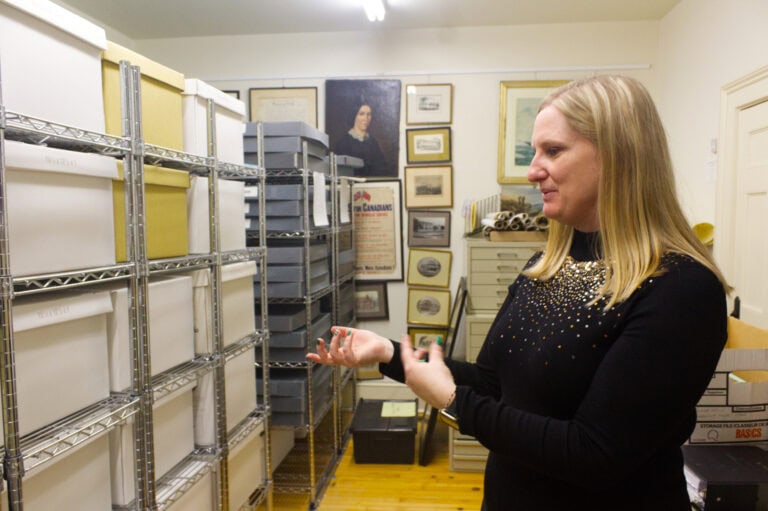The Shaw’s plans to rebuild the Royal George Theatre were met with moans and groans from an unusually packed council chamber on Tuesday.
Attendance was so high at the committee of the whole planning meeting on July 8 that committee chair Coun. Wendy Cheropita asked some attendees to move to an overflow room.
The meeting was intended to gather public input and information on the project, one part of a $150-million renovation and expansion of the Shaw Festival.
While the tone remained mostly civil, the crowd — largely opposed to the proposal — expressed its emotions with groans and even a brief round of applause.
“I’m just going to ask that we be respectful to every speaker,” said Cheropita, following a groan from the audience in response to a comment from Shaw Festival associate artistic director Kimberley Rampersad about the theatre’s proposed size.
Rampersad attended the meeting with architects Bill Lett and Meika McCunn of Unity Design Studio. Shaw Festival executive director Tim Jennings participated virtually.
The Royal George Theatre, located at 85 Queen St., is a 335-seat venue originally built during the First World War.
The Shaw Festival’s website notes it was meant to last about 25 years, but has now stood for more than a century in downtown Old Town. It is widely regarded as a staple of the festival and a beloved site in NOTL.
Jennings said the theatre requires significant upkeep and has reached the end of its lifespan.
“It is failing and must be rebuilt,” he said.
Eight delegates addressed council about the rebuild — seven opposed to it, and one in support.
While few object to the idea of a new theatre, many are concerned about how the Shaw Festival plans to proceed.
The most prominent issue is the size. The proposed new building would be located just north of the current theatre, spanning addresses from 178–188 Victoria St. and 79–83 Queen St.
It would feature a significantly larger footprint, with three floors plus a basement, covering roughly half a block. The current theatre, by contrast, has a lobby that fits only 13 people.
To accommodate the new design, part of the site would need to be rezoned from residential to commercial.
Local resident Maria Vaneva, who operates a nearby bed and breakfast with her husband, Dimitar Minkov, said the rezoning could harm both her business and quality of life.
“We sent a letter about the heritage status, the massive scale of the modern building, the public disruption, the taking down of mature trees and parking issues,” she said.
The Shaw Festival says the increased size is necessary to meet modern accessibility standards and provide space for performers, school groups, and non-profits — amenities standard in contemporary theatres.
They also argue that consolidating these functions will improve workflow.
But heritage concerns remain. Critics argue the design and location of the proposed building are out of step with the neighbourhood’s historical character.
The Shaw Festival has stated that the new building will reflect the area’s heritage. The plan would require a heritage permit.
Many residents, however, remain unconvinced.
“We’re baffled by why the Shaw is not just restoring the Royal George, but extending and rezoning,” said area resident Valmai Howe Elkins. “177 is heritage … it’s one of the oldest buildings in town.”
Elkins warned the development could damage the town’s appeal to tourists by changing the historical character of the area.
“Tourists slow down” when they reach the building, she said.
Some residents worry the project could set a precedent, potentially paving the way for more commercial developments in the heritage district.
“When we start allowing non-heritage buildings,” Elkins said, “it’s just a step before more hotels, more restaurants, coming to the neighbourhood.”
Several alternatives were proposed, including relocating the theatre outside the Queen-Picton heritage district. Vaneva, for instance, suggested the old municipal site.
Other concerns were more practical. Coun. Tim Balasiuk raised the issue of waste management related to theatre operations and construction.
“I’m a little bit concerned about the waste,” he said. “For a 360-seat theatre offering food and drink and that sort of thing, I’d love to see some creative way that that waste won’t end up on Queen Street.”
Jennings said the current theatre, with 335 seats, hasn’t posed a problem and that the new design includes hidden waste storage solutions.
These were only some of the concerns raised by residents and councillors. Both sides made emotional and passionate cases.
Minkov said he chose not to speak because of how strongly he felt, leaving the remarks to his wife. Lett also acknowledged his emotional connection to the project and the community.
Jennings said no demolition permits have been submitted, as the Shaw Festival intends to proceed in good faith with council.
With no decisions made and the meeting focused on public input, the debate around the future of the Royal George Theatre is likely far from over.











